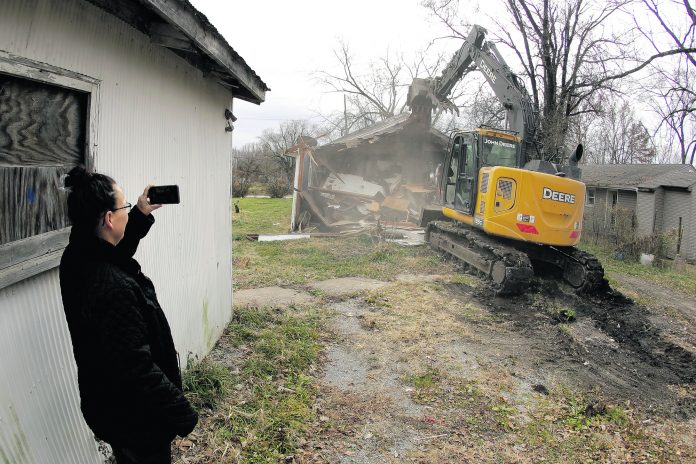
Tammy Kilgore raised the giant claw of a John Deere excavator high in the air, then slammed it down on the roof the house where she had spent nearly her entire adult life.
The shingles crunched, but not much else. So she did it again, and again — each time taking a bigger bite with the mouth-like claw, until the roof above her bedroom caved. Lumber and siding fell to the ground.
“Oh, my goodness!” she exclaimed.
The machine’s operator had given Kilgore the chance to start demolishing her own home. It’s one of dozens of flood-prone houses being torn down in this small riverside town northeast of Kansas City under a federally funded buyout program intended to reduce the risks and costs from future flooding.
When the voluntary buyouts are complete, nearly half of Mosby will be gone, leaving a patchwork of holdout homes and bare lots.
Similar buyout programs have played out in numerous communities ravaged by floods and hurricanes. Over the past three decades, federal and local governments have spent more than $5 billion to buy tens of thousands of vulnerable properties across the U.S., according to an Associated Press analysis.
This year’s devastating flooding in the Midwest, which caused billions of dollars of damage in more than a dozen states, is likely to lead to more home buyouts. And more could be necessary nationwide as climate change leads to rising seas and more frequent and intense rainstorms.
For those facing buyouts, the process can be both a blessing and curse. It can provide a fresh start for flood-weary residents who choose to leave but also sever a sense of community for those left behind.
And the process can be stressful: Kilgore, 56, suffered a heart attack in September after a long day of packing. But she was back in town on a cool November morning to watch her old house come down.
As Kilgore climbed into the excavator, longtime neighbor Betty Cazzell watched somberly from across the chain-link fence where the two would often chat. Cazzell, 86, opted against applying for a buyout. She didn’t want the hassle of leaving a town where she spent all but 10 years of her life.
“I’ve seen some changes, but they’ve been kind of gradual,” Cazzell said sadly. “This is kind of like a bomb exploding or something — it’s just all at once, and my neighbors are gone.”
The 2010 census counted 190 people in Mosby. But that seems generous these days.
Mosby began as a railroad town in 1887 nestled along the Fishing River, a tributary of the Missouri River. It grew to have its own school, bank and grocery store, but all have since closed.
Financial strains led Mosby to disband its police department in 2015. That same year, the town was flooded three times in less than six weeks. Town officials decided in 2016 to apply to the state for a nearly $3 million buyout funded largely through the Federal Emergency Management Agency.
About 50 homeowners said they were interested. It took until this summer before they received buyout offers, and about two-thirds have taken the deal.
But for some, such as 83-year-old Elmer Sullivan, the offer just wasn’t enough to afford a house somewhere else.
Sullivan was offered $20,000 for the modest home that he said he bought for $17,000 three decades ago. Since then, he put on a new roof and siding and spent $4,000 rebuilding a garage.
“This is ridiculous. This offer here ain’t no good,” Sullivan said, holding the buyout documents.
Milton and Sally Denney took the buyout for her mother’s old house, which had sat vacant since her death several years ago. But he said they turned down a $65,000 offer for their own home because it was “nowhere near enough money.”
For 65-year-old Sally Denney, who’s spent her whole life in Mosby, the buyouts have stirred a sense of disbelief, anger, frustration and fear that her beloved town could eventually be gone.
“I don’t know that it’s really all sunk in yet,” she said. But “it’s gonna hit, and it’s gonna be very sad.”
Mosby’s revenue is likely to shrink as properties once on the tax rolls become empty plots owned by the city, Mayor Harlin Clements said. The terms of the buyouts prohibit future development.
Though buyouts are disruptive, the U.S. saves $7 in avoided costs for every $1 spent through the federally funded grants to acquire or demolish flood-prone buildings, according to a study for the National Institute of Building Sciences.
“I can tell you — mitigation works, it’s very successful. It saves the pain and anguish of people that get flooded,” former FEMA Administrator James Lee Witt said during a recent session hosted by The Pew Charitable Trusts on ways to reduce local flood risks.
Like most who take buyouts, the former residents of Mosby are now scattered among nearby towns. When the Kilgores moved out, scavengers quickly swooped in to swipe their furnace, air conditioner and dishwasher. Someone even ripped out the kitchen sink and all the pipes that ran to it.
By the time Tammy Kilgore climbed into the excavator to help tear down her old house, the ransacked interior looked nothing like the home she had left.
After taking a few swings with the machine, she passed the controls to a professional. The house was reduced to a pile of rubble in barely 10 minutes.
“Well, I can say this, there’s a lot of love in them walls,” Kilgore said, adding, “I’m not sad at all.”
The Kilgores put their $45,000 buyout toward a brick house in nearby Excelsior Springs — a home on a hill.
“It’s the best decision we ever made,” she said.q



















